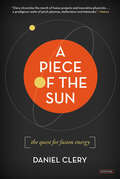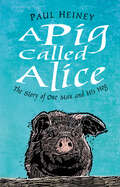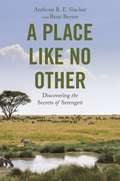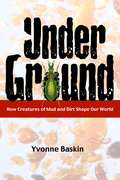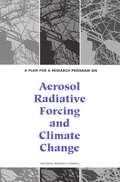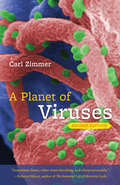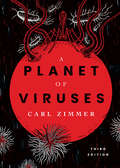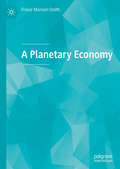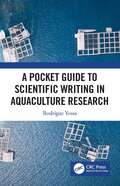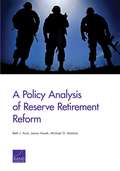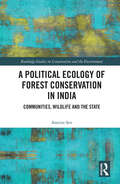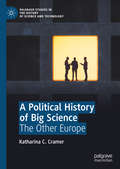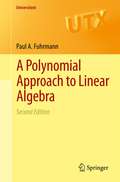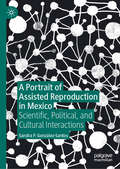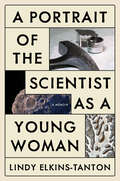- Table View
- List View
A Picture Book of Amelia Earhart
by David A. AdlerDiscusses the life of the pilot who was the first woman to cross the Atlantic by herself in a plane.
A Picture Book of Benjamin Franklin (Picture Book Biography)
by David A. AdlerWriter, printer, scientist, inventor, statesman, and youngest son in a family of seventeen children, Benjamin Franklin is considered one of our greatest Americans.Supported by colorful illustrations, Adler's biography brings to life one of America's founding fathers, Benjamin Franklin. Adler highlights Franklin's stunning accomplishments and his day-to-day life from his time as a young boy in Boston, Massachusetts through his role as the oldest delegate to the Constitutional Congress at the age of 81.A lifelong book lover and printer, Franklin poularized famous sayings like "haste makes waste" and "early to bed, early to rise, makes a man healthy, wealthy, and wise" in his annual Poor Richard's Almanack. An energetic inventor and public servant, he created the Franklin stove and bifocal glasses and established the first lending library and hospital in America.Young readers looking for insight into one of America's greatest founders, will find inspiration while gaining understanding and appreciation of US colonial history.
A Picture Book of George Washington Carver
by David A. AdlerA brief biography of the African American scientist who overcame tremendous hardship to make unusual and important discoveries in the field of agriculture.
A Piece of the Sun: The Quest for Fusion Energy
by Daniel CleryHow physicists are trying to solve our energy problems—by unlocking the secrets of the sun: &“Explain[s] cutting-edge science with remarkable lucidity.&” —Booklist This revelatory book tells the story of the scientists who believe the solution to the planet&’s ills can be found in the original energy source: the Sun itself. There, at its center, the fusion of 620 million tons of hydrogen every second generates an unfathomable amount of energy. By replicating even a tiny piece of the Sun&’s power on Earth, we can secure all the heat and energy we would ever need. The simple yet extraordinary ambition of nuclear-fusion scientists has garnered many skeptics, but, as A Piece of the Sun makes clear, large-scale nuclear fusion is scientifically possible—and perhaps even preferable to other options. Clery argues passionately and eloquently that the only thing keeping us from harnessing this cheap, clean and renewable energy is our own shortsightedness. &“Surprisingly sprightly…Clery walks readers through the history of fusion study, from Lord Kelvin, Albert Einstein and a large cast of peculiar physicists, to all manner of international politics—e.g., the darts and feints of the Cold War, the braces applied by OPEC in the wake of the 1973 war among Israel, Egypt and Syria. Clery negotiates the hard science with aplomb.&” —Kirkus Reviews &“A timely perspective on truly urgent science.&” —Booklist &“Ultimately, Clery argues that developing a source of energy that won&’t damage the climate—or ever run out—is worth striving for.&” —Publishers Weekly
A Pig Called Alice: The Story of One Man and His Hog
by Paul Heiney‘To call Alice “just another pig” would be the gravest insult.’ Alice the Large Black pig was Paul Heiney’s best friend, his confidante and his therapist. This is the story of their tempestuous relationship with all its ups-and-downs, from her arrival as a ‘large, black and expensive’ Christmas present for his wife to her last days as the matriarch of his traditional farm. In A Pig Called Alice, Heiney walks us through why lop-eared pigs are the best to raise (they can’t see you coming), how to escape a sow that’s decided you’re her next mate (throw a bucket and run), and how, actually, pigs might have just got this whole ‘life’ situation sorted out.
A Place like No Other: Discovering the Secrets of Serengeti
by Anthony R. SinclairFrom famed zoologist Anthony Sinclair, an account of his decades-long quest to understand one of Earth's most spectacular ecosystemsWith its rich biodiversity, astounding wildlife, and breathtaking animal migrations, Serengeti is like no other ecosystem on the planet. A Place like No Other is Anthony Sinclair's firsthand account of how he and other scientists discovered the biological principles that regulate life in Serengeti and how they rule all of the natural world.When Sinclair first began studying this spectacular ecosystem in 1965, a host of questions confronted him. What environmental features make its annual migration possible? What determines the size of animal populations and the stunning diversity of species? What factors enable Serengeti to endure over time? In the five decades that followed, Sinclair and others sought answers. What they learned is that seven principles of regulation govern all natural processes in the Serengeti ecosystem. Sinclair shows how these principles can help us to understand and overcome the challenges facing Serengeti today, and how they can be used to repair damaged habitats throughout the world.Blending vivid storytelling with invaluable scientific insights from Sinclair's pioneering fieldwork in Africa, A Place like No Other reveals how Serengeti holds timely lessons for the restoration and conservation of our vital ecosystems.
A Place to Start a Family: Poems About Creatures That Build
by David L. HarrisonA poetry collection introducing animal architects that build remarkable structures in order to attract a mate and have babies.Many animals build something--a nest, tunnel, or web--in order to pair up, lay eggs, give birth, and otherwise perpetuate their species. Organized based on where creatures live--underground, in the water, on land, or in the air--twelve poems bring fish, insects, reptiles, mammals, and birds to life. Back matter includes more information about each animal."A fine synthesis of poetry and science" — Kirkus Reviews"An inviting introduction to a dozen industrious creatures" — Publishers Weekly "A natural for classroom use, with eye-catching art that will lure little ones in" — Booklist ILA Teachers' Choices
A Plague of Rats and Rubbervines: The Growing Threat Of Species Invasions
by Yvonne BaskinThe human love of novelty and desire to make one place look like another, coupled with massive increases in global trade and transport, are creating a growing economic and ecological threat. The same forces that are rapidly "McDonaldizing" the world's diverse cultures are also driving us toward an era of monotonous, weedy, and uniformly impoverished landscapes. Unique plant and animal communities are slowly succumbing to the world's "rats and rubbervines"--animals like zebra mussels and feral pigs, and plants like kudzu and water hyacinth--that, once moved into new territory, can disrupt human enterprise and well-being as well as native habitats and biodiversity. From songbird-eating snakes in Guam to cheatgrass in the Great Plains, "invasives" are wreaking havoc around the world. In A Plague of Rats and Rubbervines, Yvonne Baskin draws on extensive research to provide an engaging and authoritative overview of this problem. She takes the reader on a worldwide tour of grasslands, gardens, waterways, and forests, describing the troubles caused by exotic organisms that run amok in new settings and examining how commerce and travel on an increasingly connected planet are exacerbating this oldest of human-created problems. She offers potential solutions and profiles individuals worldwide who are working tirelessly to protect the places and creatures they love. While our attention is quick to focus on purposeful attempts to disrupt our lives and economies by releasing harmful biological agents, we often ignore equally serious but much more insidious threats, those that we inadvertently cause by our own seemingly harmless actions. A Plague of Rats and Rubbervines takes a compelling look at this underappreciated problem and sets forth positive suggestions for what we as consumers, gardeners, travelers, nurserymen, fishermen, pet owners, businesspeople--indeed all of us who by our local choices drive global commerce--can do to help."
A Plague of Sheep
by Elinor G. K. MelvilleThis is a book about the biological conquest of the New World. Taking as a case study the sixteenth-century history of a region of highland central Mexico, it shows how the environmental and social changes brought about by the introduction of Old World species aided European expansion. The book spells out in detail the environmental changes associated with the introduction of Old World grazing animals into New World ecosystems, demonstrates how these changes enabled the Spanish takeover of land, and explains how environmental changes shaped the colonial societies.
A Plan for a Research Program on Aerosol Radiative Forcing and Climate Change
by National Research Council StaffThis book recommends the initiation of an "integrated" research program to study the role of aerosols in the predicted global climate change. Current understanding suggest that, even now, aerosols, primarily from anthropogenic sources, may be reducing the rate of warming caused by greenhouse gas emissions. In addition to specific research recommendations, this book forcefully argues for two kinds of research program integration: integration of the individual laboratory, field, and theoretical research activities and an integrated management structure that involves all of the concerned federal agencies.
A Planet of Viruses (Second Edition)
by Carl ZimmerThe past year has been one of viral panic--panic about viruses, that is. Through headlines, public health warnings, and at least one homemade hazmat suit, we were reminded of the powerful force of viruses. They are the smallest living things known to science, yet they can hold the entire planet in their sway. A Planet of Viruses is Carl Zimmer's eye-opening look at the hidden world of viruses. Zimmer, the popular science writer and author of National Geographic's award-winning blog The Loom, has updated this edition to include the stories of new outbreaks, such as Ebola, MERS, and chikungunya virus; new scientific discoveries, such as a hundred-million-year-old virus that infected the common ancestor of armadillos, elephants, and humans; and new findings that show why climate change may lead to even deadlier outbreaks. Zimmer's lucid explanations and fascinating stories demonstrate how deeply humans and viruses are intertwined. Viruses helped give rise to the first life-forms, are responsible for many of our most devastating diseases, and will continue to control our fate for centuries. Thoroughly readable, and as reassuring as it is frightening, A Planet of Viruses is a fascinating tour of a formidable hidden world.
A Planet of Viruses: Third Edition
by Carl Zimmer&“A captivating primer to the world of viruses that requires zero background in biology . . . a suitable first introduction to this fascinating part of our world.&” —The Inquisitive Biologist In 2020, an invisible germ—a virus—emerged and wholly upended our lives. We&’ve now become familiar with the new virus that gave us Covid-19—but viruses also cause a vast range of other diseases, including one disorder that makes people sprout branch-like growths as if they were trees. Viruses have been a part of our lives for so long that we are actually part virus: the human genome contains more DNA from viruses than our own genes. Meanwhile, scientists are discovering viruses everywhere they look: in the soil, in the ocean, even in deep caves miles underground. Fully revised and updated, with new illustrations and a new chapter about coronaviruses and the spread of Covid-19, this third edition of Carl Zimmer&’s &“information-packed, superbly readable&” A Planet of Viruses (Booklist, starred review) pulls back the veil on this hidden world. It presents the latest research on how viruses hold sway over our lives and our biosphere, how viruses helped give rise to the first life-forms, how viruses are producing new diseases, how we can harness viruses for our own ends, and how viruses will continue to control our fate as long as life endures. &“Zimmer is one of the best science writers we have today.&” —Rebecca Skloot, New York Times–bestselling author of The Immortal Life of Henrietta Lacks
A Planetary Economy
by Fraser Murison SmithThis book asks, how would a stable, prosperous economy of the future look if one started with a blank sheet of paper? Given that the world’s economy is locked into a coevolution with nature, the urgency of this question is brought into stark relief by the 2020 coronavirus pandemic and ongoing climate change. While physical technologies to build such an economy mostly exist, the social technologies, in the form of institutions, governance and policies, do not. The development of these social technologies will necessitate a reconsideration of economic norms: in particular, what is the economy for, and what are we, as actors within it, striving for? This book integrates normative, institutional, political and economic requirements into a systematic framework to drive our present growth economy toward a future planetarian one. It outlines a suite of interrelated policies to increase the economy’s material efficiency, establish a basic living standard, and reform the money system, while along the way eliminating economic debt and balancing government budgets. The framework and policies together form a paradigm of market planetarianism: the idea that the power of markets may be used to steer the economy toward a desired long-term goal. The methodological aspects of this paradigm are covered in the companion volume, Economics of a Crowded Planet.
A Pocket Guide to Scientific Writing in Aquaculture Research
by Rodrigue YossaWriting for a high-quality scientific aquaculture publication is challenging, and many students and early career aquaculture scientists find the task daunting. Expanding on his popular workshop on Improving Scientific Writing at the 2017 World Aquaculture conference, Rodrigue Yossa provides new researchers with all the tools they need to write abstracts and a variety of articles (original, research reports, magazines, working papers, conference proceedings and more). He also takes the reader step-by-step through the process of reviewing submitted manuscripts and replying to reviewers, as well as understanding research ethics. Each section is accompanied by examples, and attention is focused on providing advice on grammar, how to focus your paper and possible loopholes when writing. A Pocket Guide to Scientific Writing in Aquaculture Research offers a lifeline to aquaculture students and early career researchers getting a grasp on the basics of science communication through writing.
A Pocket History of Human Evolution: How We Became Sapiens
by Silvana Condemi François SavatierWhy aren’t we more like other apes? How did we win the evolutionary race? Find out how “wise” Homo sapiens really are. Prehistory has never been more exciting: New discoveries are overturning long-held theories left and right. Stone tools in Australia date back 65,000 years—a time when, we once thought, the first Sapiens had barely left Africa. DNA sequencing has unearthed a new hominid group—the Denisovans—and confirmed that crossbreeding with them (and Neanderthals) made Homo sapiens who we are today. A Pocket History of Human Evolution brings us up-to-date on the exploits of all our ancient relatives. Paleoanthropologist Silvana Condemi and science journalist François Savatier consider what accelerated our evolution: Was it tools, our “large” brains, language, empathy, or something else entirely? And why are we the sole survivors among many early bipedal humans? Their conclusions reveal the various ways ancient humans live on today—from gossip as modern “grooming” to our gendered division of labor—and what the future might hold for our strange and unique species.
A Pocketful of Goobers: A Story about George Washington Carver
by Barbara MitchellThere wasn't anything that George Washington Carver couldn't grow. He took the common goober--today's peanut--and created hundreds of useful products from it, turning goobers into a very profitable staple for the South. At the same time, this very special man passed on to everyone who knew him the importance of following one's own dreams.
A Polar Affair: Antarctica's Forgotten Hero And The Secret Love Lives Of Penguins
by Lloyd Spencer DavisA captivating blend of true adventure and natural history by one of today’s leading penguin experts and Antarctic explorers. George Murray Levick was the physician on Robert Falcon Scott’s tragic Antarctic expedition of 1910. Marooned for an Antarctic winter, Levick passed the time by becoming the first man to study penguins up close. His findings were so shocking to Victorian morals that they were quickly suppressed and seemingly lost to history. A century later, Lloyd Spencer Davis rediscovers Levick and his findings during the course of his own scientific adventures in Antarctica. Levick’s long-suppressed manuscript reveals not only an incredible survival story, but one that will change our understanding of an entire species. A Polar Affair reveals the last untold tale from the Heroic Age of Antarctic Exploration. It is perhaps the greatest of all of those stories—but why was it hidden to begin with? The ever-fascinating and charming penguin holds the key. Moving deftly between both Levick’s and Davis’s explorations, observations, and comparisons in biology over the course of a century, A Polar Affair reveals cutting-edge findings about ornithology, in which the sex lives of penguins are the jumping-off point for major new insights into the underpinnings of evolutionary biology itself.
A Policy Analysis of Reserve Retirement Reform
by James Hosek Beth J. Asch Michael G. MattockAs the defense burden borne by reserve forces has increased, more attention has been paid to differences between retirement systems for the reserve and active components. This report analyzes the systems, discusses the importance of structuring compensation to enable management flexibility, considers obstacles and how they might be overcome, and provides a quantitative assessment of the reserve retention and cost effects of possible proposals.
A Political Ecology of Forest Conservation in India: Communities, Wildlife and the State (Routledge Studies in Conservation and the Environment)
by Amrita SenThis book critically explores the political ecology of human marginalization, wildlife conservation and the role of the state in politicizing conservation frameworks, drawing on examples from forests in India. The book specifically demonstrates the nuances within human-environmental linkages, by showing how environmental concerns are not only ecological in content but also political. In India a large part of the forests and their surrounding areas were inhabited far before they were designated as protected areas and inviolate zones, with the local population reliant on forests for their survival and livelihoods. Thus, socioecological conflicts between the forest dependents and official state bodies have been widespread. This book uses a political ecology lens to explore the complex interplay between current norms of forest conservation and environmental subjectivities, illustrating contemporary articulation of forest rights and the complex mediations between forest dependents and different state and non-state bodies in designing and implementing regulatory standards for wildlife and forest protection. It foregrounds the issues of identity, migration and cultural politics while discussing the politics of conservation. Through a political ecology approach, the book not only is human-centric but also makes significant use of the role of non-humans in foregrounding the conservation discourse, with a particular focus on tigers. The book will be of great interest to students and academics studying forest conservation, human–wildlife interactions and political ecology.
A Political History of Big Science: The Other Europe (Palgrave Studies in the History of Science and Technology)
by Katharina C. CramerThis book investigates the political history of Big Science in Europe in the late twentieth century and the early twenty-first century, characterised by the founding histories of two collaborative, single-sited facilities namely the European Synchrotron Radiation Facility (ESRF) in Grenoble, France and the European X-Ray Free-Electron Laser (European XFEL) in Schenefeld, Germany. Under the heading of the other Europe, this book presents the history and politics of European Big Science as an alternative road to (Western) European integration besides the mainstream political integration process of the European Economic Community and the European Union. It shows that Big Science has a role to play in European politics and policymaking and that the crucial and unavoidable symbiosis between science, technology and politics brings the creation of Big Science projects back to geopolitical realities.
A Polynomial Approach to Linear Algebra (Universitext)
by Paul A. FuhrmannA Polynomial Approach to Linear Algebra is a text which is heavily biased towards functional methods. In using the shift operator as a central object, it makes linear algebra a perfect introduction to other areas of mathematics, operator theory in particular. This technique is very powerful as becomes clear from the analysis of canonical forms (Frobenius, Jordan). It should be emphasized that these functional methods are not only of great theoretical interest, but lead to computational algorithms. Quadratic forms are treated from the same perspective, with emphasis on the important examples of Bezoutian and Hankel forms. These topics are of great importance in applied areas such as signal processing, numerical linear algebra, and control theory. Stability theory and system theoretic concepts, up to realization theory, are treated as an integral part of linear algebra. This new edition has been updated throughout, in particular new sections have been added on rational interpolation, interpolation using H^{\nfty} functions, and tensor products of models. Review from first edition: "...the approach pursed by the author is of unconventional beauty and the material covered by the book is unique." (Mathematical Reviews)
A Portrait of Assisted Reproduction in Mexico: Scientific, Political, and Cultural Interactions
by Sandra P. González-SantosThis book paints a comprehensive portrait of Mexico’s system of assisted reproduction first from a historical perspective, then from a more contemporary viewpoint. Based on a detailed analysis of books and articles published between the 1950s and 1980s, the first section tells the story of how the epistemic, normative, and material infrastructure of the assisted reproduction system was built. It traces the professionalization process of assisted reproduction as a medical field and the establishment of its professional association. Drawing on ethnographic material, the second part looks at how this system developed and flourished from the 1980s up to 2010, its commercialization process, how the expansion of reproductive services took place, and the messages regarding reproductive technologies that circulated within a wide discursive landscape. Given its scope and methods, this book will appeal to scholars interested in science and technology studies, reproduction studies, history of medicine, medical anthropology, and sociology.
A Portrait of the Scientist as a Young Woman: A Memoir
by Lindy Elkins-Tanton"Fierce, absorbing, and ultimately inspiring." —ELIZABETH KOLBERT"One of the finest scientific memoirs ever written." —DAVID W. BROWNFrom one of the world’s leading planetary scientists, a luminous memoir of exploration on Earth, in space, and within oneself—equal parts ode to the beauty of science, meditation on loss, and roadmap for personal resilienceDeep in the asteroid belt between Mars and Jupiter, three times farther from the sun than the Earth is, orbits a massive asteroid called (16) Psyche. It is one of the largest objects in the belt, potentially containing the equivalent of the world’s total economy in metals, though they cannot be brought back to Earth. But (16) Psyche has the potential to unlock something even more valuable: the story of how planets form, and how our planet formed. Soon we will find out, thanks to the extraordinary work of Lindy Elkins-Tanton, the Principal Investigator of NASA’s $800 million Psyche mission, and the second woman ever to be awarded a major NASA space exploration contract.The journey that brought her to this place is extraordinary. Amid a childhood of terrible trauma, Elkins-Tanton fell in love with science as a means of healing and consolation. But still she wondered, was forced to wonder: as a woman, was science “for her”? In answering that question, she takes us from the wilds of the Siberian tundra to the furthest reaches of outer space, from the Mayo Clinic, where Elkins-Tanton battled ovarian cancer while writing the Psyche proposal, to NASA’s Jet Propulsion Laboratory, where her team brought that proposal to life.A Portrait of the Scientist as a Young Woman is a beautifully-constructed memoir that explores how a philosophy of life can be built from the tools of scientific inquiry. It teaches us how to approach difficult problems by asking the right questions and truly listening to the answers—and how we may find meaning through exploring the wonders of the universe around us.
A Pound of Prevention for a Healthier Life: How and Why Avoiding Exposures to Toxic Chemicals and Other Sources of Oxidative Stress, the Cause of Most Disease, Lowers the Odds of Getting Sick
by Harold I ZeligerA Pound of Prevention for a Healthier Life shows the connection between oxidative stress and the onset of virtually all disease and discusses the causes of oxidative stress induced disease and ways to prevent it. The book includes a unique questionnaire for predicting disease onset in seemingly healthy people, and shows how steps taken to prevent any one disease may prevent many other unrelated diseases.Dr. Harold I. Zeliger, a chemical toxicologist who has been researching the causes of non-communicable diseases for more than 40 years, demonstrates how elevated oxidative stress is responsible for attacks on virtually all body organs and systems and how it triggers the onset of numerous diseases, including ADHD, autism, heart disease, respiratory disease, diabetes, obesity, Alzheimer's disease, Parkinson's disease, cancer and numerous others. The many sources of oxidative stress include not only exposures to toxic chemicals such as pesticides, air pollutants, PCBs and organic solvents, but also to radiation, tobacco smoke, eating some foods, pharmaceutical drug use, illnesses a person already has, emotional stress and others.Zeliger's research shows how elevated oxidative stress need not come from a single source, but can come from multiple sources, and that it is total oxidative stress, no matter what the source or sources, that causes disease. The Oxidative Stress Index, which can be individually arrived at from the questionnaire in the book, allows the reader to determine his or her oxidative stress level, which sources are responsible for it, and what actions can be taken to reduce it and lower the likelihood of disease onset.
A Powerful Particulars View of Causation (Routledge Studies in Metaphysics)
by R.D. IngthorssonThis book critically examines the recent discussions of powers and powers-based accounts of causation. The author then develops an original view of powers-based causation that aims to be compatible with the theories and findings of natural science. Recently, there has been a dramatic revival of realist approaches to properties and causation, which focus on the relevance of Aristotelian metaphysics and the notion of powers for a scientifically informed view of causation. In this book, R.D. Ingthorsson argues that one central feature of powers-based accounts of causation is arguably incompatible with what is today recognised as fact in the sciences, notably that all interactions are thoroughly reciprocal. Ingthorsson’s powerful particulars view of causation accommodates for the reciprocity of interactions. It also draws out the consequences of that view for issue of causal necessity and offers a way to understand the constitution and persistence of compound objects as causal phenomena. Furthermore, Ingthorsson argues that compound entities, so understood, are just as much processes as they are substances. A Powerful Particulars View of Causation will be of great interest to scholars and advanced students working in metaphysics, philosophy of science, and neo-Aristotelian philosophy, while also being accessible for a general audience. The Open Access version of this book, available at http://www.taylorfrancis.com/books/9781003094241, has been made available under a Creative Commons Attribution-Non Commercial-No Derivatives 4.0 license.



